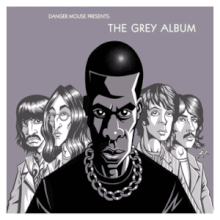Grey Album
| The Grey Album | ||||
|---|---|---|---|---|
 |
||||
| Remix album (bootleg) by Danger Mouse | ||||
| Released | February 2004 | |||
| Recorded | 30 May – 14 October 1968 (The Beatles' sessions), 2003 (Jay-Z's session) | |||
| Genre | Hip hop, rap rock, mashup | |||
| Length | 44:36 | |||
| Producer | Danger Mouse | |||
| Danger Mouse chronology | ||||
|
||||
| Alternative cover | ||||

Promotional artwork by Justin Hampton. This was not used for the actual cover, but appeared on the Danger Mouse website.
|
||||
| Professional ratings | |
|---|---|
| Aggregate scores | |
| Source | Rating |
| Metacritic | 79/100 |
| Review scores | |
| Source | Rating |
| AllMusic | |
| Christgau's Consumer Guide | |
| Entertainment Weekly | A |
| NME | 10/10 |
| The Observer | |
| Pitchfork | 7.7/10 |
| Q | |
| Spin | A |
| Tiny Mix Tapes | 4/5 |
| URB | |
The Grey Album is a mashup album by Danger Mouse, released in 2004. It mixes an a cappella version of rapper Jay-Z's The Black Album with samples from The Beatles' LP The Beatles, commonly known as "The White Album". The Grey Album gained notoriety when EMI attempted to halt its distribution despite approval of the project from Jay-Z and the two surviving Beatles, Paul McCartney and Ringo Starr.
Danger Mouse created The Grey Album as an experimental project intended for a limited 3,000-copy release in February 2004. While Danger Mouse never asked permission to use the Beatles' material, Jay-Z's a cappella recordings, though copyrighted, were released commercially for the purpose of encouraging mashups and remixes. A buzz around the album resulted in wider Internet distribution and media attention garnering a glowing review in the February 9, 2004 issue of The New Yorker. The Grey Album was named the best album of 2004 by Entertainment Weekly and ranked #10 in The Village Voice's annual Pazz and Jop critics poll.
Brian Burton (Danger Mouse) is quoted as saying:
A lot of people just assume I took some Beatles and, you know, threw some Jay-Z on top of it or mixed it up or looped it around, but it's really a deconstruction. It's not an easy thing to do. I was obsessed with the whole project, that's all I was trying to do, see if I could do this. Once I got into it, I didn't think about anything but finishing it. I stuck to those two because I thought it would be more challenging and more fun and more of a statement to what you could do with sample alone. It is an art form. It is music. You can do different things, it doesn't have to be just what some people call stealing. It can be a lot more than that.
...
Wikipedia
